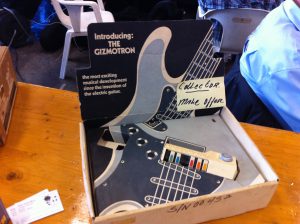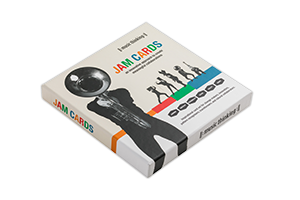
There are many books written about creativity and creativity is not just a skill or a magic wand that helps us when we are desperately looking for solutions for big problems. There are many ways of being creative, and this can be in small and simple but also in complicated or even complex situations.
There is a big difference between complicated and complex. For the former, it might help to reduce the complicated elements in smaller simpler units (like it is done in agile development), for the latter that is not possible. It needs a different way of creativity.
The Jam Card

There is no simple solution to a complex problem. Instead of looking for the next simple quick fix for something that is nearby, we should think about how to understand the complexity, what level of complexity do we experience and how is the complexity changing. This means complexity is not a problem to be solved but a system you can only understand when you are a part of the system and try to change it. This needs creativity in many dimensions and many senses. It’s like dancing the waltz with a complex system, having fun in mutual changing development instead of analyzing and trying to fix it. So have fun with complexity, embrace the paradox.
The picture
 This is a snapshot I did with my iPhone on a Vintage Guitar Show in the Netherlands. Besides many guitars from decent to crazy, there are also many accessories to tune, maintain or enhance your guitar, amp or yourself. One of these is the Gizmotron. The Gizmotron, is an effects device for the electric guitar. It was invented in 1969 and patented by the English rock musicians Kevin Godley and Lol Creme in 1975, whilst they were members of the British rock group 10cc. Taped or permanently attached to the body of an instrument, the Gizmotron uses small, motor-driven plastic/rubber wheels to make the strings vibrate, yielding resonant, synthesizer-like sounds from each string. Plagued with design and manufacturing problems, the Gizmotron did not live up to expectations and was a commercial failure. In this regard, it became a collector’s item.
This is a snapshot I did with my iPhone on a Vintage Guitar Show in the Netherlands. Besides many guitars from decent to crazy, there are also many accessories to tune, maintain or enhance your guitar, amp or yourself. One of these is the Gizmotron. The Gizmotron, is an effects device for the electric guitar. It was invented in 1969 and patented by the English rock musicians Kevin Godley and Lol Creme in 1975, whilst they were members of the British rock group 10cc. Taped or permanently attached to the body of an instrument, the Gizmotron uses small, motor-driven plastic/rubber wheels to make the strings vibrate, yielding resonant, synthesizer-like sounds from each string. Plagued with design and manufacturing problems, the Gizmotron did not live up to expectations and was a commercial failure. In this regard, it became a collector’s item.
The quote
Creativity is more than just being different. Anybody can play weird – that’s easy. What’s hard is to be as simple as Bach. Making the simple complicated is commonplace – making the complicated simple, awesomely simple – that’s creativity.
This is a great quote from Charlie Mingus, a great musician and bass player. He understands that creativity is not just a single trick (being weird or different) but part of a bigger system and Johann Sebastian Bach is a great example. It also shows that Mingus is looking far more than his Jazz experience to the area of classical or baroque music. That Mingus was an inventive innovator with a broad view not only in music can be seen in the inspirational links below, he was also a cat lover.
The music
The Brandenburg Concertos by Johann Sebastian Bach (BWV 1046–1051, original title: Six Concerts à plusieurs instruments) are a collection of six instrumental works presented by Bach to Christian Ludwig, Margrave of Brandenburg-Schwedt in 1721. They are widely regarded as some of the best orchestral compositions of the Baroque era. Bach used the “widest spectrum of orchestral instruments … in daring combinations,” as Christoph Wolff has commented.
“Every one of the six concertos set a precedent in scoring, and every one was to remain without parallel.” Heinrich Besseler has noted that the overall forces required (leaving aside the first concerto, which was rewritten for a special occasion) tally exactly with the 17 players Bach had at his disposal in Köthen. source: wikipedia
Here is a side story: when my daughters were young, I made for them mixtapes with the most different musical pieces. From classical to Punk, Jazz, Rock or Pop to instrumental, German, Italian and English songs. Among others, there was also the excerpt of the Brandenburgische Konzerte you hear above. My eldest daughter walked daily with a cassette recorder through our apartment. One day when we had guests and were sitting on the table, she entered the room with her recorder, put it on the table and was explaining: ‘and this is Bach’, then she left the room and an astonishing group of people thinking about the well educated and musically talented little girl.
The cues
SCORE, JAMMIN’ and REMIX are three cues that connect with complexity. They live in the solution space and have the potential to quickly prototype and iterate new possibilities. JAMMIN” with the power to invent, listen and create, SCORE with the power of visualising the outcome or documenting the hypothesis and REMIX as the master of shipping, of creating something of value to use or perform. See here: how the cues connect with the Music Thinking Framework.
Some inspirational links:
John Maeda the laws of simplicity
Gizmotron 2.0
Charles Mingus Cat Toilet Training Program
Music Thinking Jam Cards
 An inspirational card set for change makers, pattern recognisers, innovators, transformers and natural collaborators. The Jam Cards consist of 38 inspiration cards and six cue cards. All inspiration cards have a keyword, a visual and a sonic trigger, a trigger question, an inspirational quote, and six cues that connect with the Music Thinking Framework. You can use the cards from a strategic point of view, knowing what you want or need and a serendipity approach open to everything that will happen. ‘Music Thinking’ lets people work and play together in a new way with inspirations from the rich world of music.
An inspirational card set for change makers, pattern recognisers, innovators, transformers and natural collaborators. The Jam Cards consist of 38 inspiration cards and six cue cards. All inspiration cards have a keyword, a visual and a sonic trigger, a trigger question, an inspirational quote, and six cues that connect with the Music Thinking Framework. You can use the cards from a strategic point of view, knowing what you want or need and a serendipity approach open to everything that will happen. ‘Music Thinking’ lets people work and play together in a new way with inspirations from the rich world of music.
Order the Music Thinking Jam Cards.
You can order the jam cards via your local bookstore (worldwide) and have a nice chat with the people there and try the cards right away, or just buy them directly at BIS Publishers. Yes, you can also find them at Amazon.com, Amazon.de, and Bol.com

One thought on “Creativity, or how can we waltz with complexity?”
Comments are closed.